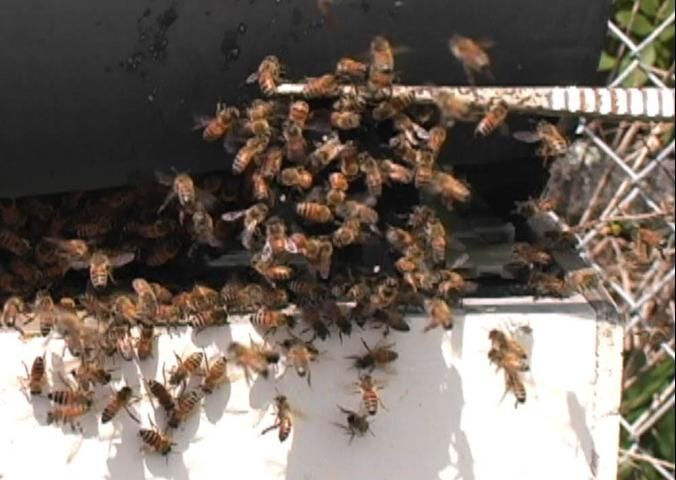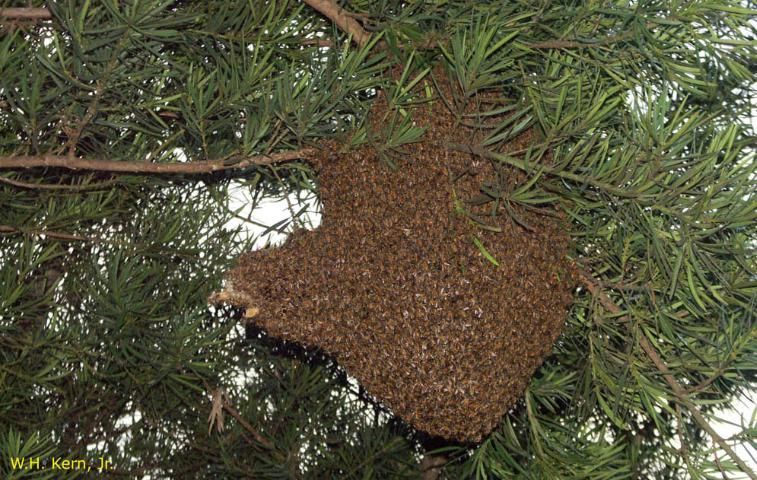African honey bees (AHB –Box 1) and European honey bees (EHB) are the same species (Apis mellifera), but the two are classified as different sub-species. European honey bees (the honey bee most familiar to Americans) were first introduced to the Americas in the early 1600's by European explorers. For centuries, European honey bees have been selected by beekeepers for their robust honey production and storage behavior, their reduced regular swarming (colony splitting) tendencies, and their gentleness. The African honey bee (Apis mellifera scutellata) was brought to Brazil in the 1950s in an effort to increase honey production. However, 26 queens were accidentally released and thrived in Brazil's native environment, crossbreeding with European Honey Bees to produce the Africanized Honey Bee. Since then, Africanized bees have spread throughout South America, Central America, and into the southwestern United States and Florida. The Africanized honey bee is considerably more defensive than its European cousin. Consequently, it is important to understand key differences between the defensive Africanized bee and the docile European honey bee.
Visual Appearance
Africanized honey bees are slightly (approximately 10%) smaller than European honey bees. However, this size difference is very subtle, and it is nearly impossible to differentiate between the two without specific measurements and/or laboratory testing. The Florida Department of Agriculture and Consumer Services uses a morphometric test called FABIS (Fast African Bee Identification System) to identify colonies that have been eradicated from throughout the southeastern United States. If a bee's identity remains questionable after FABIS testing, FDACS will use a more comprehensive morphometric test, USDA-ID (Universal System for the Detection of African honey bees), to confirm the colony's identity.
Hive Defense and Stinging
Unlike wasps and hornets, honey bees can only sting once, and will die shortly afterward. Stinging is often a last resort in hive defense.
The venom of the Africanized honey bee is no more potent than that of the European honey bee. For a fatality to occur from venom toxicity, it normally would take about 10 stings per pound of body weight, from either an Africanized or European honey bee. The main difference between the European and Africanized honey bee is its defense response; an Africanized honey bee colony, if disturbed, will send more guard bees to sting, and will pursue for a longer distance and stay agitated for a longer period of time, than a European honey bee.

Credit: Ian McGuire, UF/IFAS

Credit: Ian McGuire, UF/IFAS
Swarming and Absconding
Swarming is a natural occurrence when the colony gets too large and resources are abundant. The colony rears a new queen and the hive splits roughly in half, creating two separate colonies. Absconding occurs when resources are scarce or there is a threat to the hive. The entire colony will abandon the hive for a new location. For more information about swarming, see Swarm Control for Managed Beehives (https://edis.ifas.ufl.edu/in970).

Credit: W. H. Kern, Jr., UF/IFAS
Selection of Nesting Site
Because Africanized honey bees swarm more often, fewer individuals are involved in each swarm, meaning they do not require a large cavity to build a nest and are often discovered in water meter boxes (Figure 4) and other man-made cavities. Having evolved in regions with constant resource availability, along with small nests and frequent swarming, AHBs do not have the same drive to store large reserves of honey like EHBs. European honey bees need a larger volume nesting site and tend to nest in hollowed tree cavities (Figure 5).

Credit: UF/IFAS Honey Bee Research and Extension Laboratory

Credit: UF/IFAS Honey Bee Research and Extension Laboratory

Credit: W. H. Kern, Jr., UF/IFAS
Resources
- UF/IFAS EDIS Documents, Subtopic Africanized Honey Bees
https://edis.ifas.ufl.edu/entity/topic/africanized_honey_bee
This site has extension documents with detailed information on AHB biology and distribution and on keeping your family and community safe from AHBs.
- AFBEE Program
https://entnemdept.ufl.edu/honey-bee/beekeeper-resources/african-bees/
The African Honey Bee Extension and Education Program was established by the Florida Department of Agriculture and Consumer Services and the University of Florida, and serves to educate all Floridians about the presence of African bees in Florida.
- Florida Department of Agriculture and Consumer Services, Division of Plant Industry, Bureau of Plant and Apiary Inspection, African Honey Bee Page https://www.fdacs.gov/Consumer-Resources/Health-and-Safety/Africanized-Honey-Bees
FDACS website provides links to videos, fact sheets, press releases, and more. It also includes a list of trained professionals available for bee removalor eradication.
Table 1.
Table 2.
Table 3.